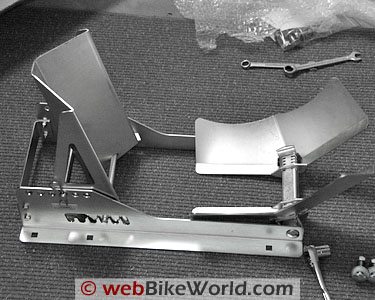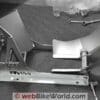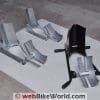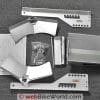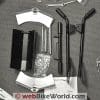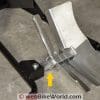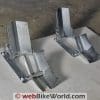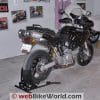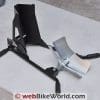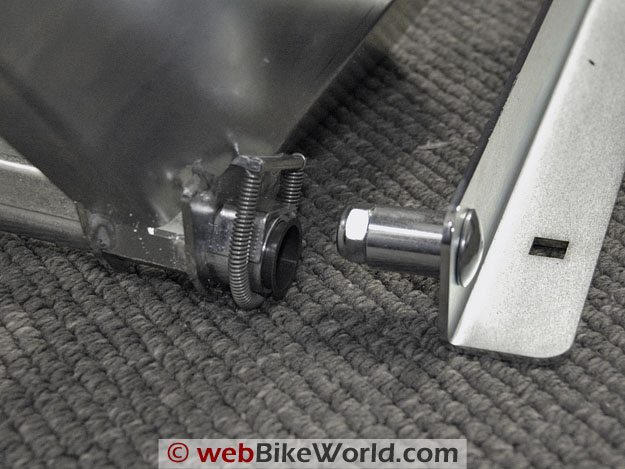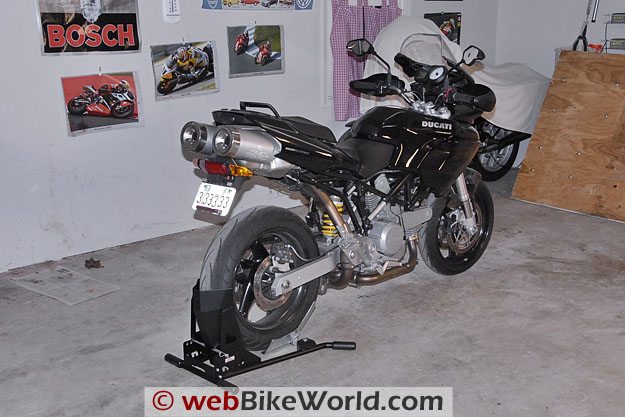All four SteadyStand wheel stands and chocks made by Acebikes are precision-made, nicely designed and quality products that we can highly recommend.
We reviewed the “original” Acebikes SteadyStand in February of 2008 and found it to be a nicely engineered design that has proven to be very useful in the garage.
There are several motorcycle wheel chocks or front wheel stands to choose from, but the SteadyStand has a simple and ingenious no-fuss design that works well.
The original portable SteadyStand has a fixed-width wheel ramp, or cup and backstop designed to fit Sportbike-sized tires from 90 to 130 mm wide and wheels from 15 to 19 inches in diameter.
So how do you make a good product even better? Introducing the Acebikes SteadyStand “Multi”, with an adjustable wheel ramp and backstop!
The Multi will fit a huge variety of wheel widths and diameters.
Acebikes says it will fit everything from big-wheeled scooters to cruisers with wheel diameters from 15″ to 21″ and tire widths from 90 mm to 200 mm.
The SteadyStand Multi is available in two versions: the portable version, similar to the original SteadyStand we reviewed, comes in Rohm and Haas RAL 7016 Anthracite powder coating.
The Acebikes SteadyStand Multi Fixed, which can be easily bolted to a motorcycle trailer or flatbed for a semi-permanent installation, is galvanized steel.
The Multi is enormously useful, because it can be very easily adjusted — with no tools, mind you — to fit probably any motorcycle you’ll ever own. And get this: it will fit both front and rear wheels!
Just to put a little icing on the cake, the Acebikes designers also developed a fixed version of the original SteadyStand. The SteadyStand Fixed has a narrow chassis and should fit on “rail” type motorcycle trailers.
We’re going to replace the very clumsy front wheel holder on our Rocket folding motorcycle trailerwith the SteadyStand Fixed as soon as the weather clears up.
Want more good news? The SteadyStand is made in the Netherlands and was sold only in Europe, but our review generated so much interest that Acebikes has now set up a North American distributor (see the summary table below).
Now if we can only convince Acebikes to send over their very cool-looking “Down Loader” motorcycle trailer with a floor that raises and lowers, we’ll be all set!
So what makes the SteadyStand design so special? Let’s take a look…
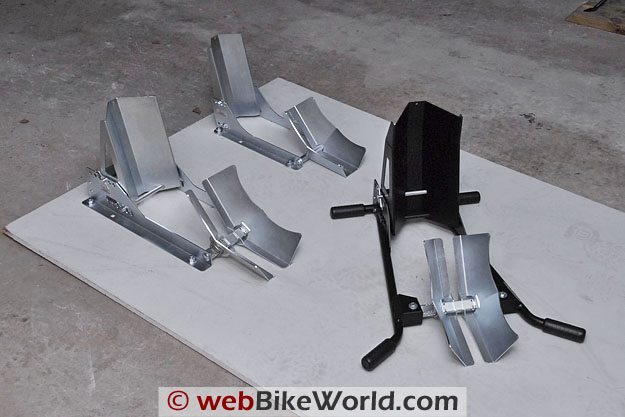
SteadyStand Front Wheel Chocks
The SteadyStand wheel chocks arrive in a fairly small box, an laying out all the parts for inspection can make assembly look like a daunting project.
But it’s actually pretty easy to combine all those bits into a functional stand — just study the CAD drawing provided in the kit, which lists all the parts and illustrates how they all go together.
It takes only minimal mechanical skills to throw one together, and only a few hand tools. We used drops of blue Loctite here and there just to make sure the nuts stay with the bolts.
Here are two photos, the first illustrating the parts provided in the SteadyStand Multi Fixed kit, which include a bag with the hardware and four carriage bolts, washers and Nylock nuts to use when mounting the stand on a motorcycle trailer.
The second photo illustrates all of the parts that come in the SteadyStand Multi portable stand:
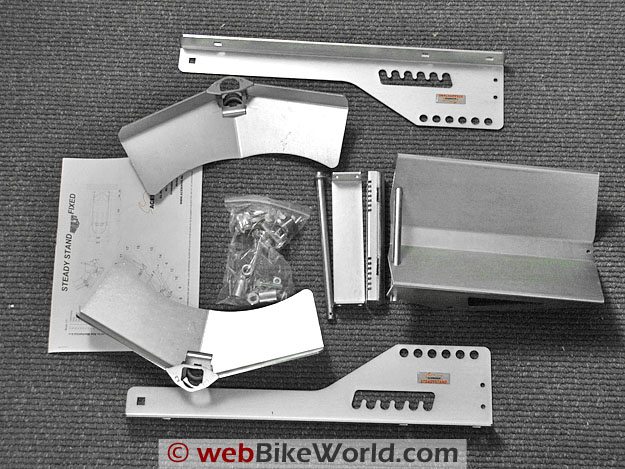
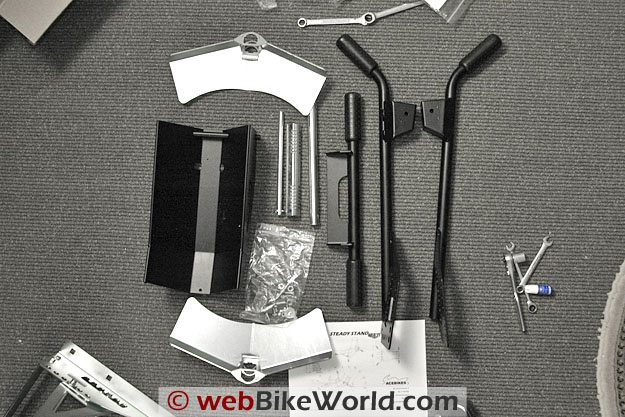
Assembly
The only two tips I can offer are to 1) Lay out all the parts and check them against the parts list on the drawing, as this will help identify what goes where; 2) Study the drawing carefully before proceeding to understand how it all fits together, and take your time.
After the minimal assembly, the stands are ready to go.
The SteadyStand Multi uses an ingenious design for adjusting the “wings”, or sides of the wheel ramp/wheel cup. A horizontal cross bar fits between the frame of the stand, and the bar is notched to hold the wings as they’re moved in and out.
A spring fits under the bar and around to the other side to hold each side of the wheel ramp in place with enough room to move it for adjustment.
Each side must be tilted back and then it slides over to fit into one of the notches cut into the bar. The video we included below shows how to make these adjustments.
Here’s a close-up photo of the SteadyStand Multi Fixed, illustrating how the horizontal adjustment bar fits to one of the side rails of the stand frame.
Note the black plastic or nylon insert that fits inside the cross bar serves as a bushing or bearing for the cross bar and the wheel ramp to rotate back and forth. It fits over the short rod shown below.
The spring is also obvious in this photo:
The next photo shows how the sides of the wheel ramp or cup can be adjusted, in this case to fit a narrower tire.
This is the SteadyStand Multi portable unit, but the principle is exactly the same as on the Multi Fixed version.
The yellow arrow points to the grooves cut into the cross bar, which hold the sides in place:
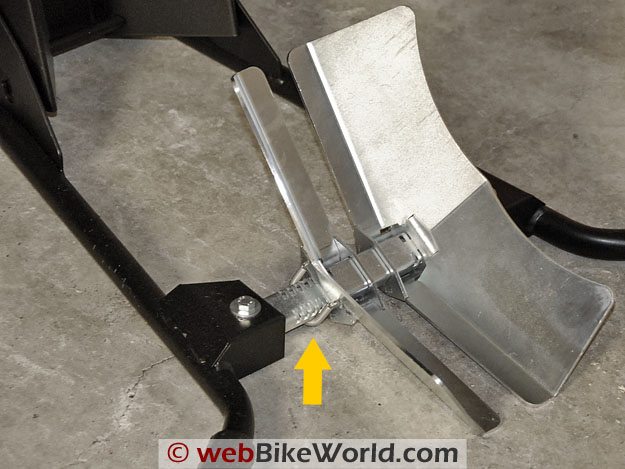
The rear of the SteadyStand Multi Fixed has cutouts on the lower portion to set the distance of the back of the wheel stand from about 15″ if set all the way towards the rear (right) to about 21″ if set all the way to the front (left).
The cotter pin on top slips into a shaft that holds the back plate in place, and it is moved one hole forward or back to match the position of the bottom lug.
Note how clean the holes and cuts are on the SteadyStand; it looks like it was cut with either a CNC water jet, laser or plasma cutter.
Note also that the mounting bolts shown in the photos are mounted upside-down so we could lay the plywood on the floor. The holes for the carriage bolts are square, as you can see in the photo below in the hole to the right of the bolt.
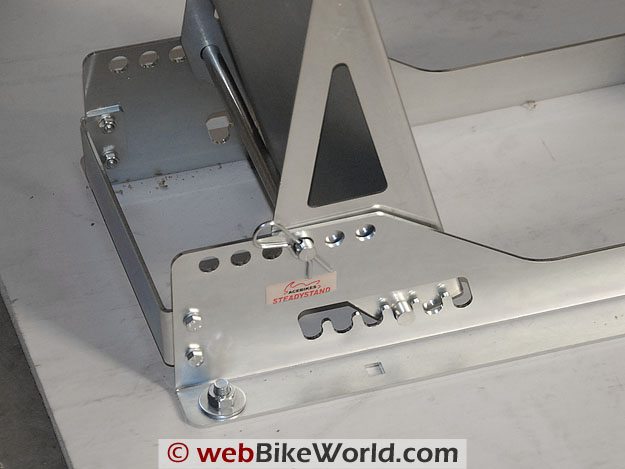
SteadyStand Multi Fixed and Fixed Front Wheel Stands
Just for the record, next is a photo of the SteadyStand Multi Fixed on the left, compared to the SteadyStand Fixed (non-Multi; i.e., not adjustable) on the right.
The SteadyStand Fixed is narrow and compact and should fit on just about any trailer, including “rail” type motorcycle trailers.
If you’re only going to carry Sportbikes, or motorcycles with tires from 90 to 130 mm wide and wheels from 15 to 19 inches in diameter, the SteadyStand Fixed (non-adjustable) should work fine.
It is also narrower, which may work for certain types of motorcycle trailers.
For a few dollars (or Euros) more, you can buy the SteadyStand Multi Fixed, which is adjustable over a wide range of tire widths and wheel diameters, and which also works on rear tires, as you can see in the photo below and in our video.
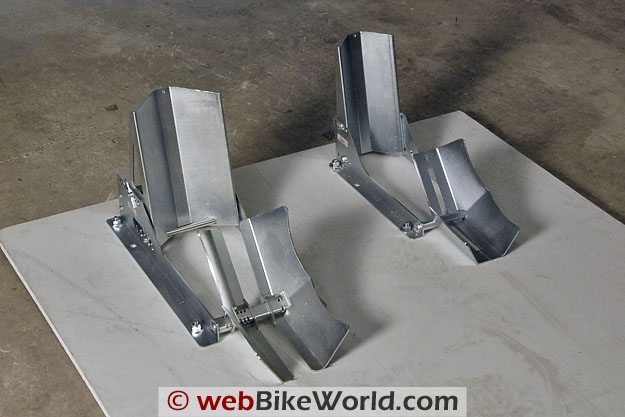
The “Fixed” versions of the SteadyStand are primarily designed for mounting on a trailer, but I don’t see any reason why you couldn’t also mount one on a piece of plywood for use in the garage, although this would raise the height of the wheel holder.
Why Use a Front Wheel Stand?
A webBikeWorld visitor wrote not long ago and asked “Where and why would you want to use one of these?”, referring to the various front wheel chock and wheel stand reviews we’ve published.
My response is this: The SteadyStand Multi portable is very useful in the garage for holding the bike upright by the front or rear tire.
It works especially well for parking the bike right near the wall of the garage, because the bike doesn’t have to be leaned over on its side stand, taking up more room than necessary.
If your bike doesn’t have a center stand, you’ll need some type of wheel chock or stand anyway.
And even if it does, the versatility of the SteadyStand Multi, which holds the bike by either the front or rear wheel, makes it much easier to perform routine maintenance.
Add in the adjustability of the Multi, and the Fixed version for mounting on a trailer, and it’s an accessory that quite honestly we can’t live without.
[UPDATE: In mounting this on a flatbed trailer, I noted that the square mounting holes are apparently metric, and they measure out to a 7/16″ carriage bolt in the U.S. (11 mm).
Unfortunately, 7/16″ carriage bolts are as rare as hen’s teeth, I couldn’t find them after going to three different hardware stores. There is a 3/8″ and a 1/2″ but no 7/16″.
They are available because I found them in an online search, but they’re not very common. So I used 3/8″ instead, but the square part of the carriage bolt has a lot of play in it, I hope it holds.]
Here’s a photo of the Multistrada 620, parked in the SteadyStand Multi portable, held by its rear wheel. The rear tire on this bike is 160 mm wide and the wheel is 17″ in diameter.
Next is a photo of the SteadyStand Multi portable. The rubber grips on what appear to be the handles hold the stand in place as the bike is rolled on and off and they also provide a grip for the owner to pick up and carry the stand.
One wall of this garage is a peg board and we can hang the SteadyStand on the wall on a couple of hooks for storage.
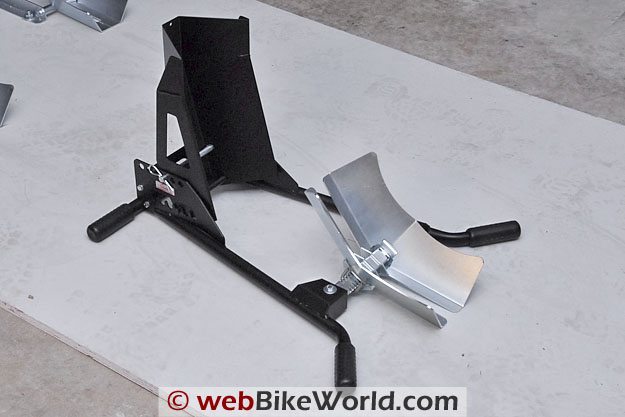
Conclusion
As I wrote in the review of the original SteadyStand, “the beauty of the SteadyStand is its simplicity combined with its sturdy feel.
It’s so easy to wheel the motorcycle on and off the stand, yet it does a good job of holding the bike for light maintenance and repairs. It has become one of the most useful items in the garage and I highly recommend it.”
I couldn’t say it better this time, except to add that the Multi version of the SteadyStand makes it even more useful, especially around here where a multitude of bikes are coming in and out of the garage, with a variety of wheel sizes and tire widths.
The adjustability of the wheel holder and the back stop doesn’t seem to have hurt the sturdy feel of the SteadyStand one bit. When the SteadyStand is properly adjusted for the tire size, it holds the bike firmly in place.
We’ve now tried four different SteadyStands made by Acebikes, and we’re convinced these are well-made, very well designed and quality products that we can highly recommend.
Winner: wBW 2008 Motorcycle Accessory of the Year Award!
More webBikeWorld:
Owner Comments and Feedback
See details on submitting comments.
From “M.G.” (4/10): “I recently purchased the Multi portable based on your review and would like to say that I was not disappointed. It works great in both the garage and transporting a bike in the back of my truck.
On a recent trip I found it worked perfect in the back of the truck and also at the camp ground. The camp ground did not have surfaces suitable for side stand only parking not to mention the 40 mile an hour wind gust that we had on the first night.
The wind that night made the campers and utility trailers rock but the bike stayed steady under the heavy wind.
Thanks for your time and efforts in writing the review.”


